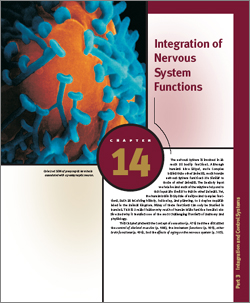
 | The nervous system is involved in almost all bodily functions. Although humans have larger, more complex brains than other animals, most human nervous system functions are similar tothose of other animals. The sensory input we receive and most of the ways we respond to that input are similar to that in other animals. Yet, the human brain is capable of unique and complex functions, such as recording history, reasoning, and planning, to a degree unparalleled in the animal kingdom. Many of these functions can only be studied in humans. That is a major reason why much of human brain function remains elusive and why it remains one of the most challenging frontiers of anatomy and physiology. This chapter presents the concept of sensation (p. 476) and then discusses the control of skeletal muscles (p. 488), the brainstem functions (p. 495), otherbrain functions (p. 496), and the effects of aging on the nervous system (p. 503). |